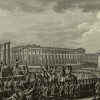Place de la Concorde
Situated at the end of Champs-Elysées in Paris, Place de la Concorde is a townsquare with a bloody history. The title directly translates to Peace and Harmony, and was built in 1757. The square was originally given the name ‘Place de Louis XV’. During the French Revolution, a bloody war, the square changed dramtically. In 1792, the statue at the center was destroyed and and the square was renamed, Place de la Revolution (Revolution Square). During this revolution, the guillotine -- an instrument used to behead people -- was placed in the square, and Place de la Revolution soon turned into a bloodstained stage for all the world to witness as this revolution descended in anarchy. The people of the revolution executed more than 1200 people in Place de la Revolution, with each executuion surrounded by cheering crowds.
Notable beheadings were King Louis XVI, his wife, Marie Antoinette, and their own leader of the revolution, Maximilien. This brief, terrible period (called the Reign of Terror) came to an end in 1795, and the square was renamed Peace and Harmony in an attempt to make peace with it's history. Today, we see the Place de la Concorde as one of the most notable instinces of "villianization." Monarchs and rulers were subject to the media, and stories were spread. Whether false or true, each leader was swept up into a flurry of anger by the people, and days later, would find themselves at the guillotine. This square acted as the breeding ground for speculation and anger, creating the "witch hunt" of the Romantic period.
A notable example of this is Marie Antoinette's final words before the guillotine. We learn today that she offensively cried out, "let them eat cake!" when in reality, she accidentally trod on the executioner's foot. She whispered, “Pardon me sir, I didn't mean to.” These were her final words. This issue of fake news is an issue we see today, and has spread throughout history.
While the Romantic period is famous for free-thinking and new ways of writing and seeing the world, there remains bloodshed in it's wake. This period is to appluaded, but it is important to remember that the French Revolution, and the Place de la Revolution act as the first chapter in this age. Free-thinking comes with change. Whether or not the French Revolution achieved the change they yearned for, the revolution can be attributed as the event that opened the door towards such thinking.
Parent Map
Coordinates
Longitude: 2.321235700000



